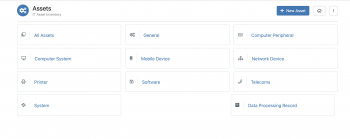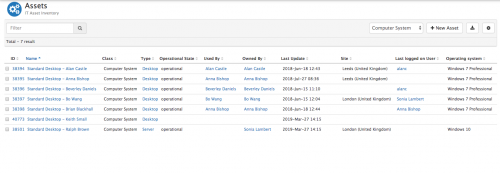Manage Assets
| Home > Service Manager > Asset Management > Manage Assets | Index |
IntroductionThe Manage Assets feature provides the options for adding, updating, and removing assets. Asset are managed through an asset list where assets can be searched for, opened, and viewed. |
Related Articles |
Assets Landing Page
When you first select the Manage Assets option a tiled Assets Landing Page is displayed, showing the different available Asset Classes. Clicking on any of the tiles will display an asset list with all the assets belonging to that class.
The available Classes include:
- All Assets
- This will display all assets, independent of there class. The available information in this view will be generic to all asset classes.
- Computer Peripherals
- Keyboards, Monitors, Keyboards, and other types of computer peripherals can be viewed by selecting this option
- Computer Systems
- Servers, Desktop Computers, and other types of computer systems can be viewed by selecting this option
- General
- Assets types that don't fall under the standard classes can be listed here. This may be things like desks and other office equipment.
- Mobile Devices
- Smart phones and tablets are the common types of assets listed here
- Network Devices
- Routers, switches, physical firewalls, and other network devices
- Printers
- Laser, InkJet, scanners, fax machines
- Software
- See a list of software
- Telecoms
- Phone systems, desk phones, and other communication assets
- Systems
- business information, ownership and authorizing contacts across the business
- Data Processing Record
- Record of Processing Activity (ROPA)
Asset List
The Asset List lets you access all the available assets. A number of features on the Asset List are available to help you locate your assets and view and export information about these assets.
Tool Bar Features
- Add a New Asset
- The New Asset button allows for the manual creation of an asset. This button is located on both the Asset Landing Page and the Asset List. Adding an Asset Manually
 Batch processing or the adding of multiple assets can also be achieved by using the Upload Assets CSV
Batch processing or the adding of multiple assets can also be achieved by using the Upload Assets CSV Automated processing using an external data source can be achieved by using the Database Asset Import
Automated processing using an external data source can be achieved by using the Database Asset Import
- Quick Filter
- The filter can be used to quickly focus on those asset records that are important to you. The filter will operate on the asset records that appear in the current list and will return records where a match is found in any of the asset attributes.
- 1.) To search on the Class-specific attributes of an asset record, you must be viewing a Class-specific list.
- 2.) It will search all asset attributes regardless of whether or not the attribute is displayed in your list view.
- 3.) The filter does not operate on attributes containing a date-time value, state, location type, acq. method, or depreciation method (however sorting on these columns should allow effective identification of the records of interest).
- Advanced Search
- Use the advanced search option to filter assets based on multiple definable conditions. Before adding your first Condition make sure you select the appropriate Asset Class from the Class Selector. Once you start adding the first Condition, the Asset Class will be locked to the current Asset Class and the matching fields for that Asset Class will be available when adding conditions. Once Conditions are set use either the search option to filter the results and or saved the search as one of your views.
- Class Selector
- Switch between Asset Classes or All assets by selecting the relevant option (Note the list columns will change to reflect those configured for each Asset Class).
- Add a New Asset
- The New Asset button allows for the manual creation of an asset. This button is located on both the Asset Landing Page and the Asset List. Adding an Asset Manually
 Batch processing or the adding of multiple assets can also be achieved by using the Upload Assets CSV
Batch processing or the adding of multiple assets can also be achieved by using the Upload Assets CSV Automated processing using an external data source can be achieved by using the Database Asset Import
Automated processing using an external data source can be achieved by using the Database Asset Import
- Views
- The Views provide a way of defining and storing a number of different views of the assets. The criteria builder lets you specify conditions based on information held in the asset records, giving you quick access to particular sets of important data. You can quickly change your Views by selecting from your list of defined views on the Asset List toolbar.
- Export Assets
- Export the contents of the Asset list to CSV
- Choose which of the available columns on the list you wish to export (the available options will be specific to the asset class)
- Home View
- The Home View allows you to create a preferred or default view of your Asset List. Your Home View is displayed when you first visit your Asset List and with a single click you can return to your Home View from any other filter or view which you have applied.
- Customize Columns
- The available columns will be specific to the Asset Type the list is using. The available columns will be a combination of the common attributes which all Asset Types share, and the Type Specific attributes for the selected Asset Type. If choosing to display All Assets only the shared asset attributes will be available to select from.
List Features
- Column Sorting
- Each column header allows the order of the list to be changed by clicking on the title of each column
- View an Asset
- Each Asset in the list contains links to open the Asset Details form
- Delete an Asset
- Using the multi-select check boxes, one or more assets can be selected. Once selected the Delete button becomes available in the Asset List tool bar. Multiple assets can be selected by clicking on one asset, and then while holding down the Shift key and select another asset. All assets between these two assets will be selected and available for deleting.

